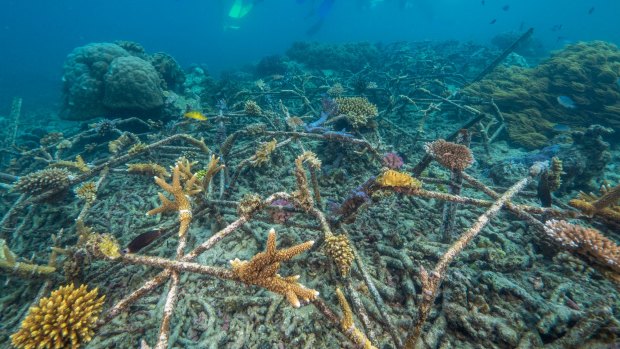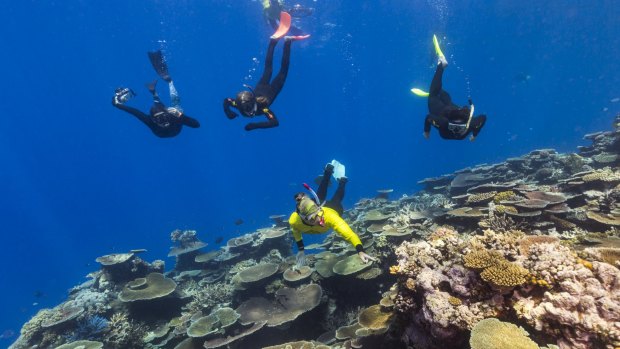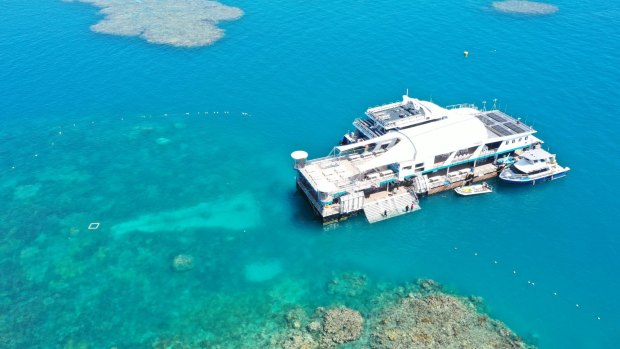This was published 1 year ago
Grow-your-own coral: How science is giving the Great Barrier Reef a helping hand
By Kerry van der Jagt

The installation of Australia's first Reef Star system system is a coral rubble stabilisation technique that uses hexagonal-shaped, steel structures, to which fragments of live coral are attached.Credit: Tourism and Events Queensland
The Humphead wrasse has been stalking us during our snorkel across Moore Reef. Pouty as a petulant teenager the juvenile sashays between our small group of six, grazing a thigh here, bumping an ankle there. Further below, the inky world of the Great Barrier Reef is a Monet masterpiece of mauve mushroom corals and purple-tipped staghorns. As we duck-dive, shoals of phosphorescent fish change direction in unison, fluent in the dialect of the deep, they travel as one.
Yet this section of the outer reef has not been millions of years in the making, rather it is just over two years old.
"We planted these Mars Reef Stars in June 2020," says Eric Fisher of GBR Biology and our guide for the snorkel tour from the Reef Magic pontoon, 40 kilometres offshore from Cairns.

The project on the Great Barrier Reef, to boost coral resilience, is a collaboration with Mars Sustainable Solutions, part of Mars Incorporated, and Reef Magic Cruises, alongside James Cook University and Indigenous rangers.Credit: Tourism and Events Queensland
"In 18 months we've seen a 50 per cent increase in coral in our research patch."
The installation of Australia's first Reef Star system system – known as the Mars Assisted Reef Restoration System (MARRS) – is a coral rubble stabilisation technique that uses hexagonal-shaped, steel structures, to which fragments of live coral are attached.
These grit-coated stars are connected together underwater in a web and "planted" into bare patches of degraded reef. After a few years, the coral completely overgrows the Reef Stars, which become fully integrated into the reef structure.

The Reef Magic pontoon, 40 kilometres offshore from Cairns.Credit: Reef Magic
The project on the Great Barrier Reef, to boost coral resilience, is a collaboration with Mars Sustainable Solutions, part of Mars Incorporated, and Reef Magic Cruises, alongside James Cook University and Indigenous rangers.
"Our goal is to stabilise rubble areas, increase coral cover and ultimately, to validate the technique," says Fisher. Our heads bob above the luminesce surface. Small waves ruffle the ocean, yet below the water is as still as an aquarium.
As part of a five-year scientific study, the Reef Magic team plans to install more than 50 additional Reef Stars every six months. Our snorkel with Eric leads us over patches planted in October 2020, May 2021 and December 2021, the skeletal arms of the most recent stars still visible through the sea-garden.
"We have planted 348 stars across four separate builds," says Fisher.
On a separate snorkel we drift over a forest of pastel plate corals, before swimming along a section of the outer reef wall. Here, a marine medley of fluorescent pink, purple and lemon-coloured corals meets the indigo of the deep sea. All around, fish flit and fall like rose petals. It's reassuring to see such natural colour and diversity across Moore Reef, not just in the research area.
Back on board the Reef Magic pontoon, "Remoora", the newest and most technologically advanced pontoon on the reef, the three-level structure is designed and built for a sustainable future, producing its own energy through 18 solar panels and three wind turbines.
Fisher leads us through the research laboratory, where marine biologists conduct experiments and give daily talks. Depending on the project, visitors are welcome to participate, ask questions or simply stop by and watch.
Afterwards, we join Master Reef Guide Dustin Maloney for a glass bottom boat ride and interpretive tour. He is one of 82 guides across the Great Barrier Reef Marine Park, from the Ribbon Reefs in the north to Lady Elliot in the south. As reef ambassadors, these specially trained and selected guides impart up-to-date scientific and management information about the reef and explain what visitors can do to make a difference.
As the program's first Indigenous Master Reef Guide - with connections to Kuku-Yalanji, Yirrganydji, Yidinji and Gunggandji clan groups - Dustin brings his cultural knowledge to help safeguard the reef, while sharing stories about the importance of his people's Sea Country.
Gliding across sections of colourful reef Dustin shows us an array of traditional tools and weapons, explaining that his people would only hunt large marine mammals, such as dugongs or turtles, at certain times of the year according to lore. "We'd use every part of the animal – organs, flesh, skin and bones," he says. "And then we'd trade the bones with our inland neighbours for making spear heads."
Today, Reef Magic pontoon is being used for tourism, but next week it will be a research base for the assemblage of another 90 stars.
An immersive experience to help create an appreciation of the World Heritage site is key, according to snorkelling guide Fisher.
"The more people feel connected to this iconic natural wonder, the more they feel driven to protect and conserve this global asset."
THE DETAILS
TOUR
A day-tour to Reef Magic pontoon from $279 an adult and $139 a child, includes snorkelling equipment, buffet lunch, glass bottom boat tour and entry to underwater observatory. SCUBA diving, snorkel tours and helmet diving are at additional cost. See reefmagic.com.au
Guided snorkel tours over the Reef Stars need to be booked directly through GBR Biology gbrbiology.com
STAY
On the esplanade in Cairns, the five-star Crystalbrook Flynn offers city-view room from $325. crystalbrookcollection.com
MORE
Kerry van der Jagt travelled as a guest of Tourism and Events Queensland.
Sign up for the Traveller Deals newsletter
Get exclusive travel deals delivered straight to your inbox. Sign up now.